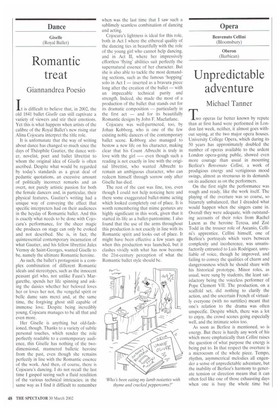Giselle (Royal Ballet)
Romantic treat
Giannandrea Poesio
It is difficult to believe that, in 2002, the old 1841 ballet Giselle can still captivate a variety of viewers and stir their emotions. Yet this is what happens when artists of the calibre of the Royal Ballet's new rising star Alina Cojocaru interpret the title role.
It is unfortunate that the way of writing about dance has changed so much since the days of Theophile Gautier, the dance writer, novelist, poet and ballet librettist to whom the original idea of Giselle is often ascribed. Despite what would be regarded by today's standards as a great deal of pedantic quotations, an excessive amount of politically incorrect remarks and an overt, not purely artistic passion for both the female dancers and, in particular, their physical features, Gautier's writing had a unique way of conveying the effect that specific interpreters had on their audiences in the heyday of Romantic ballet. And this is exactly what needs to be done with Cojocaru's performance, for the sheer magic she produces on stage can only be evoked and not described. She is, in fact, the quintessential contemporary incarnation of what Gautier, and his fellow librettist Jules Vernoy de Saint-Georges, wanted Giselle to be, namely the ultimate Romantic heroine.
As such, the ballet's protagonist is a complex combination of different Romantic ideals and stereotypes, such as the innocent peasant girl who, not unlike Faust's Margarethe, spends her life spinning and asking the daisies whether her beloved loves her or loves her not, the vengeful spirit or belle dame sans merci and, at the same time, the forgiving ghost still capable of immense love. Despite being incredibly young, Cojocaru manages to be all that and even more.
Her Giselle is anything but old-fashioned, though. Thanks to a variety of subtle personal touches, which render the role perfectly readable to a contemporary audience, this Giselle has nothing of the twodimensional, mannered balletic heroine from the past, even though she remains perfectly in line with the Romantic essence of the work. And then, of course, there is Cojocaru's dancing. I do not recall the last time I gasped seeing such a fluid rendition of the various technical intricacies; in the same way as I find it difficult to remember when was the last time that I saw such a sublimely seamless combination of dancing and acting.
Cojocaru's lightness is ideal for this role, both in Act I where the ethereal quality of the dancing ties in beautifully with the role of the young girl who cannot help dancing, and in Act IL where her impressively effortless 'flying' abilities suit perfectly the supernatural essence of her character. But she is also able to tackle the most demanding sections, such as the famous 'hopping' solo in Act I — inserted as a bravura piece
long after the creation of the ballet with an impeccable technical purity and strength. Indeed, she made the most of a production of the ballet that stands out for its dramatic composition — particularly in the first act — and for its beautifully Romantic designs by John F. Macfarlane.
Cojocaru was well-partnered, too, by Johan Kobborg, who is one of the few existing noble dancers of the contemporary ballet scene. Kobborg also managed to bestow a new life on his character, making clear that his Count Albrecht is truly in love with the girl — even though such a reading is not exactly in line with the original librettist, who wanted Albrecht to remain an ambiguous character, who can redeem himself through sorrow only after Giselle has died.
The rest of the cast was fine, too, even though I could not help noticing here and there some exaggerated ballet-mime acting which looked completely out of place. It is worth remembering that mime gestures are highly significant in this work, given that it started its life as a ballet-pantomime. I also found that the use of the arms throughout this production is not exactly in line with its Romantic spirit and looks out of place. It might have been effective a few years ago when this production was launched, but it clashes vividly with what has now become the 21st-century perception of what the Romantic ballet style should be.


































































 Previous page
Previous page